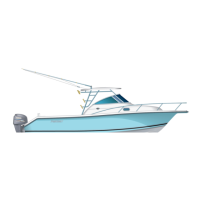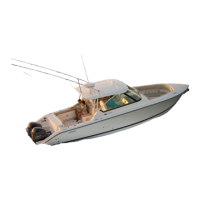Do you have a question about the PURSUIT 2570 offshore and is the answer not in the manual?
Details on the limited warranty statement and registration process.
Information on Pursuit's right to change equipment or specifications without notice.
Procedure and conditions for transferring the boat's warranty to a new owner.
Guidance on obtaining warranty repairs from authorized dealers and customer relations.
Requirements for boat registration, numbering display, and certificate validity.
Legal responsibilities and recommendations for boat insurance coverage.
Procedures and timelines for reporting boating accidents to authorities.
Recommendations for boating safety courses and educational programs.
List of safety equipment mandated by the U.S. Coast Guard for boats.
Overview of propulsion system design and engine manual importance.
Addresses marine growth and galvanic corrosion issues for outboard motors.
Details lubrication requirements for 2-cycle and 4-cycle outboard engines.
Explains raw water cooling and the importance of water flow for engine operation.
Information on propeller selection, sizing, and maintenance for optimal performance.
Explains helm gauges and alarms for monitoring engine status and performance.
Introduction to the three primary helm control systems: throttle, steering, and trim tabs.
Operation of single-lever binnacle controls for engine throttle and gear selection.
Function of the neutral safety switch to prevent engine starting in gear.
How to use power tilt and trim for engine positioning and boat attitude adjustment.
Proper use of the engine stop switch and lanyard for safety.
Explanation of the hydraulic steering system components and maintenance.
Operation and adjustment of trim tabs for controlling hull attitude and stability.
Guidance on compass compensation and adjustment for accurate navigation.
Routine maintenance for control systems, including steering and trim tabs.
Overview of fuel system design, inspection, and safety regarding gasoline odors.
Details on the fuel tank, withdrawal lines, anti-siphon valves, and fuel filters.
Step-by-step guide for safe fueling, emphasizing fire prevention and static electricity.
Information on oil tanks and indicator systems for 2-cycle engines.
Routine maintenance for fuel system components like primer bulbs and connections.
Introduction to the 12-volt DC electrical system and battery types.
Details the dual battery setup and power distribution via circuit breakers.
Components of the DC distribution system, including battery switches and breakers.
Description of breaker panels and accessories controlled by helm switches.
Overview of fresh water system components, operation, and pump protection.
Operation and priming of the raw water washdown pump.
Details on the livewell pump, sea strainer, and operational guidelines.
Information on gravity drainage systems and thru-hull fittings.
Routine maintenance for fresh water, raw water, and drainage systems.
How cabin ventilation is achieved through hatches and port windows.
Refers to the safety chapter for vital information on CO and ventilation.
Operation of the opening vent panels on the windshield.
Describes the vents providing airflow to the bilge compartment.
Maintenance for ventilation components like hinges, latches, and acrylic glass.
Details on deck hardware, bow pulpit, anchor locker, and optional windlass.
Information on the swim platform, engine mounting, and boarding ladder.
Covers windshield, stern seat, sink, fishbox, and transom door in the cockpit area.
Description of cabin access, storage, V-berth, and lighting features.
Operation and maintenance of the marine toilet and holding tank system.
Refers to the safety chapter for important CO detector information.
Information on optional stereo and CD changer systems.
Overview of safety equipment and U.S. Coast Guard standards.
Explains audible engine alarms and recommended actions when they sound.
Importance and function of the neutral safety switch for engine starting.
Guidance on proper use of the engine stop switch and lanyard.
Hazards of carbon monoxide, detector function, and poisoning symptoms.
Operator's responsibility for first aid and recommendations for a marine first-aid kit.
List of safety equipment mandated by the U.S. Coast Guard, including PFDs.
Suggestions for extra safety gear like EPIRBs and VHF radios.
Emphasizes pre-operation familiarization, checks, and safety compliance.
Basic navigation rules for safe boating and collision avoidance.
Essential checks before starting engines, including weather, documents, and gear.
Guidelines for safe boat operation, passenger safety, and handling.
Safety considerations for operating while fishing, especially with a tower.
Safety precautions for operating the boat from a tower helm.
Techniques for docking, anchoring, and mooring, including line handling.
Procedures for handling propulsion, control, or steering system failures.
Immediate actions to take after a collision, focusing on passenger safety and boat inspection.
Legal requirements and advice for assisting vessels or freeing grounded boats.
Steps to take if the boat becomes flooded or capsizes.
Guidance on professional boat transport and hull support.
Tips for safe trailering, including vehicle capability and trailer selection.
Procedures for recovering a person who has fallen overboard.
Safety precautions for towing water skiers, including PFD use.
Regulations and practices for marine waste and trash disposal.
General advice before using cleaning products and handling urethane foam.
Hull cleaning below waterline, bottom painting, and gelcoat surface care.
Cleaning and maintenance for vinyl upholstery, canvas, and enclosures.
Cleaning the cabin interior, including teak, carpet, and mildew prevention.
Maintenance for the bilge area, focusing on cleaning and corrosion protection.
Procedures for preparing the boat for storage, including fuel, water systems, and lifting.
Step-by-step winterization for various boat systems like fresh water and engines.
Reactivating the boat after storage and preparing it for launch.
Troubleshooting steps for issues with hydraulic steering and neutral safety switches.
Solutions for sluggish performance, loss of speed, and boat vibration.
Common engine issues like overheating, charging problems, and RPM limitations.
Troubleshooting for issues with accessories like livewell pumps and bilge pumps.

